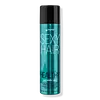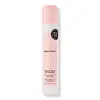What's inside
What's inside
 Key Ingredients
Key Ingredients

 Benefits
Benefits

 Concerns
Concerns

 Ingredients Side-by-side
Ingredients Side-by-side

Hydrofluorocarbon 152a
Alcohol Denat.
AntimicrobialDimethyl Ether
SolventAluminum Starch Octenylsuccinate
AbsorbentZeolite
AbsorbentPropylene Glycol
HumectantWater
Skin ConditioningSilica
AbrasiveParfum
MaskingPanthenol
Skin ConditioningHelianthus Annuus Seed Extract
Skin ConditioningButylene Glycol
HumectantLimonene
PerfumingBenzyl Salicylate
PerfumingButylphenyl Methylpropional
PerfumingBenzyl Alcohol
PerfumingBenzyl Benzoate
AntimicrobialHydroxycitronellal
PerfumingHydrofluorocarbon 152a, Alcohol Denat., Dimethyl Ether, Aluminum Starch Octenylsuccinate, Zeolite, Propylene Glycol, Water, Silica, Parfum, Panthenol, Helianthus Annuus Seed Extract, Butylene Glycol, Limonene, Benzyl Salicylate, Butylphenyl Methylpropional, Benzyl Alcohol, Benzyl Benzoate, Hydroxycitronellal
Dimethyl Ether
SolventWater
Skin ConditioningPvp
Emulsion StabilisingPropanediol
SolventHelianthus Annuus Seed Extract
Skin ConditioningEpilobium Angustifolium Flower/Leaf/Stem Extract
Skin ConditioningEriobotrya Japonica Leaf Extract
Skin ConditioningLarix Europaea Wood Extract
HumectantCamellia Sinensis Leaf Extract
AntimicrobialPolyglyceryl-4 Caprate
EmulsifyingGlycerin
HumectantButylene Glycol
HumectantGlycine
BufferingParfum
MaskingSilica
AbrasivePhenoxyethanol
PreservativeChlorphenesin
AntimicrobialSodium Metabisulfite
AntioxidantCitric Acid
BufferingZinc Chloride
AntimicrobialHexyl Cinnamal
PerfumingBenzyl Salicylate
PerfumingLinalool
PerfumingLimonene
PerfumingCitronellol
PerfumingDimethyl Ether, Water, Pvp, Propanediol, Helianthus Annuus Seed Extract, Epilobium Angustifolium Flower/Leaf/Stem Extract, Eriobotrya Japonica Leaf Extract, Larix Europaea Wood Extract, Camellia Sinensis Leaf Extract, Polyglyceryl-4 Caprate, Glycerin, Butylene Glycol, Glycine, Parfum, Silica, Phenoxyethanol, Chlorphenesin, Sodium Metabisulfite, Citric Acid, Zinc Chloride, Hexyl Cinnamal, Benzyl Salicylate, Linalool, Limonene, Citronellol
Ingredients Explained
These ingredients are found in both products.
Ingredients higher up in an ingredient list are typically present in a larger amount.
Benzyl Salicylate is a solvent and fragrance additive. It is an ester of benzyl alcohol and salicylic acid. This ingredient can be naturally found in some plants and plant extracts.
In fragrances, Benzyl Salicylate may be a solvent or a fragrance component. In synthetic musk scents, it is used as a solvent. For floral fragrances such as lilac and jasmine, it is used as a fragrance component. The natural scent of Benzyl Salicylate is described as "lightly-sweet, slightly balsamic".
While Benzyl Salicylate has been associated with contact dermatitis and allergies, emerging studies show it may not be caused by this ingredient alone.
However, this ingredient is often used with fragrances and other components that may cause allergies. It is still listed as a known allergen in the EU. We recommend speaking with a professional if you have concerns.
Another study from 2021 shows Benzyl Salicylate may have anti-inflammatory properties.
Learn more about Benzyl SalicylateButylene Glycol (or BG) is used within cosmetic products for a few different reasons:
Overall, Butylene Glycol is a safe and well-rounded ingredient that works well with other ingredients.
Though this ingredient works well with most skin types, some people with sensitive skin may experience a reaction such as allergic rashes, closed comedones, or itchiness.
Learn more about Butylene GlycolThis ingredient is also known by its brand name, Dymel-A.
It is a colorless gas and often used in aerosols.
Helianthus Annuus Seed Extract comes from sunflower seeds.
Sunflower seeds are rich in vitamin E. Studies show sunflowers contain antimicrobial and antioxidant properties.
The fatty acids found in sunflower seeds include (from highest amount to least): linoleic acid, myristic acid, palmitic acid, stearic acid, arachidic acid, oleic acid, and linolenic acid.
These fatty acids hydrate your skin. Emollients create a film on the skin to prevent moisture from escaping.
Learn more about Helianthus Annuus Seed ExtractLimonene is a fragrance that adds scent and taste to a formulation.
It's found in the peel oil of citrus fruits and other plants such as lavender and eucalyptus. The scent of limonene is generally described as "sweet citrus".
Limonene acts as an antioxidant, meaning it helps neutralize free radicals.
When exposed to air, oxidized limonene may sensitize the skin. Because of this, limonene is often avoided by people with sensitive skin.
The term 'fragrance' is not regulated in many countries. In many cases, it is up to the brand to define this term. For instance, many brands choose to label themselves as "fragrance-free" because they are not using synthetic fragrances. However, their products may still contain ingredients such as essential oils that are considered a fragrance.
Learn more about LimoneneParfum is a catch-all term for an ingredient or more that is used to give a scent to products.
Also called "fragrance", this ingredient can be a blend of hundreds of chemicals or plant oils. This means every product with "fragrance" or "parfum" in the ingredients list is a different mixture.
For instance, Habanolide is a proprietary trade name for a specific aroma chemical. When used as a fragrance ingredient in cosmetics, most aroma chemicals fall under the broad labeling category of “FRAGRANCE” or “PARFUM” according to EU and US regulations.
The term 'parfum' or 'fragrance' is not regulated in many countries. In many cases, it is up to the brand to define this term.
For instance, many brands choose to label themselves as "fragrance-free" because they are not using synthetic fragrances. However, their products may still contain ingredients such as essential oils that are considered a fragrance by INCI standards.
One example is Calendula flower extract. Calendula is an essential oil that still imparts a scent or 'fragrance'.
Depending on the blend, the ingredients in the mixture can cause allergies and sensitivities on the skin. Some ingredients that are known EU allergens include linalool and citronellol.
Parfum can also be used to mask or cover an unpleasant scent.
The bottom line is: not all fragrances/parfum/ingredients are created equally. If you are worried about fragrances, we recommend taking a closer look at an ingredient. And of course, we always recommend speaking with a professional.
Learn more about ParfumSilica, also known as silicon dioxide, is a naturally occurring mineral. It is used as a fine, spherical, and porous powder in cosmetics.
Though it has exfoliant properties, the function of silica varies depending on the product.
The unique structure of silica enhances the spreadability and adds smoothness, making it a great texture enhancer.
It is also used as an active carrier, emulsifier, and mattifier due to its ability to absorb excess oil.
In some products, tiny microneedles called spicules are made from silica or hydrolyzed sponge. When you rub them in, they lightly polish away dead skin layers and enhance the penetration of active ingredients.
Learn more about SilicaWater. It's the most common cosmetic ingredient of all. You'll usually see it at the top of ingredient lists, meaning that it makes up the largest part of the product.
So why is it so popular? Water most often acts as a solvent - this means that it helps dissolve other ingredients into the formulation.
You'll also recognize water as that liquid we all need to stay alive. If you see this, drink a glass of water. Stay hydrated!
Learn more about Water